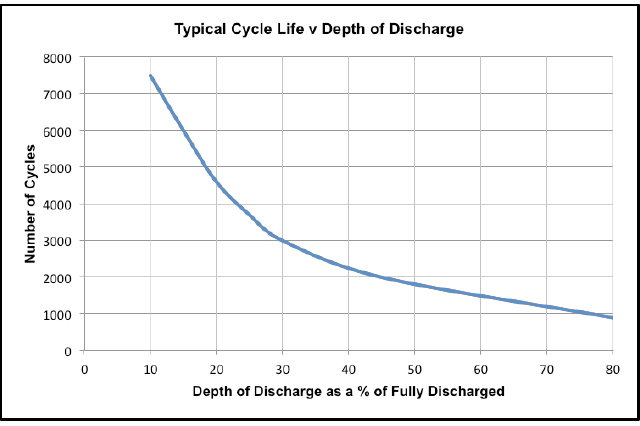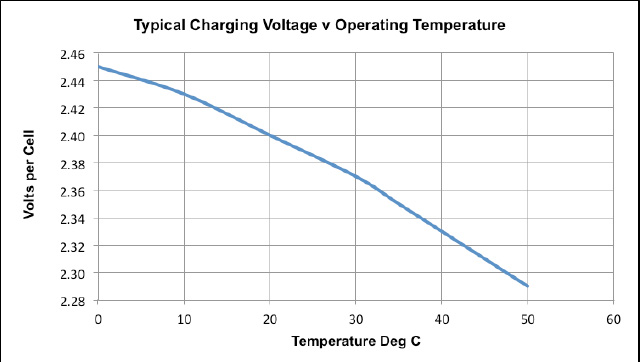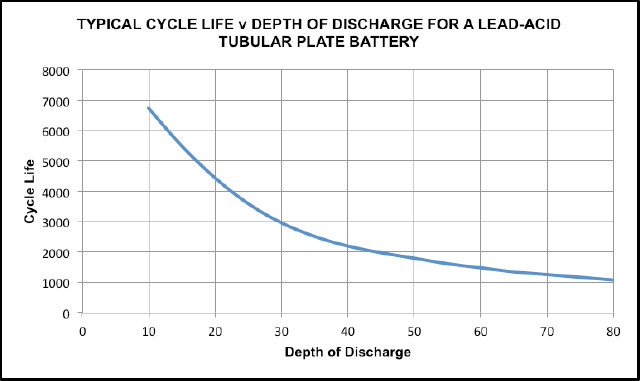Lead Acid Batteries For Cycling Applications.
There have been many myths about lead-acid battery cycling.
This article will give the reader a better understanding of the more important aspects of battery cycling and battery choice. Different applications are discussed along with charger requirements and how the number of cycles varies with the depth of discharge. This article looks at applications where the recharge is not regular such as solar and wind charging. Intermittent diesel charging is also discussed.
This article does not include cycling applications such as those for motive power applications where the battery is completely isolated form the load for recharging.
CYCLING BATTERY DEFINITION
In this article we are only interested in “true” cycling batteries. Batteries that are used regularly for applications such as switch closing & tripping or engine starting do not fall into the scope of this article.
A cycling battery can be defined as one that is subjected to frequent but not necessarily regular discharges and recharges. The discharge may be of relatively short duration but at a relatively high current or vice versa. The discharge may remove all of the capacity from the battery or only a little and the recharge may be a full recharge to 100% capacity or a partial charge.
In some cycling applications, the discharge may be considered as over a full year followed by a 100% recharge under controlled parameters. For this type of application the battery is usually removed from the site for recharging.
SOLAR OR WIND APPLICATIONS
Solar applications are becoming more popular but present a new challenge. The night-time discharge will normally remove a reasonable capacity form the battery but there must be sufficient left in reserve to provide the next night-time demand even if the battery is not fully charged by the solar panel.
Typically, depending on the reliability of the weather, calculations can be made to minimize the battery and solar panel sizes. For example, in some applications, the capacity returned during daylight hours may be small or even negligible and the battery must have a large reserve. A calculation must be made to determine the minimum capacity required to bridge the gap between acceptable recharging periods. In applications where the solar energy is small, it may be necessary to install a secondary recharge system such as a diesel generator. It may be that this only needs to run for 24h once every month for some parts of the year. A system where the battery is only recharged fully by a diesel generator similar is desirable if a good cycle life is to be expected.
In other applications we may find just the opposite. Sun may be relied upon for 360 days a year but we must have something in reserve.
In all applications we need some reserve power not only to cover for times when the sun does not recharge the battery correctly but if an acceptable cycle life is to be achieved. We do not want to completely discharge the battery. An example of the number of cycles available form a battery may be 7000 cycles to a 10% depth of discharge to 1000 cycles when the depth is 80%. Cycling batteries should never be discharged below 80% discharged.
Clearly, the solar array will need to have current and voltage controlled.
Wind powered systems are very similar but can have the advantage of charging when there is no daylight. On the other hand, lack of acceptable wind force can severely disrupt the charging cycle.
In both solar and wind applications, it is not unusual for a diesel generator to be present on site. By carefully monitoring the battery voltage either on load or open circuit, the generator can be automatically started to recharge the battery.

APPLICATIONS WITH BOTH SOLAR AND WIND POWER CHARGING
These applications are to all intent and purpose similar to the solar or wind application.
Both solar panel and wind power charging characteristics will need to be integrated and meet a common characteristic for charging. From an electronics point of view this is simple.
CYCLING WITH MAINS OR DIESEL POWER RECHARGING
It may be argued that if mains power is available then there will be no need for a battery to discharge. Some applications may have a limited a.c. power supply that is far less than the load demands during peak times. The addition of a battery to cater for these peak demand times is not unusual.
If the cycle is regular, the choice of battery capacity is relatively easy. We need to know the power requirements for the load and the power available from the a.c. mains and we can then choose a battery charging regime to suit.
Ideally, the charging cycle should put back at least what was removed but without overcharging the battery. Overcharging will reduce the battery life. The battery load will inevitable vary if only slightly and some sort of automatic charge termination will be required. To complicate issues, the load may have tight voltage limits and the charger will need to have an upper voltage limit if it is an “on line” battery system. It will be necessary to calculate the approximate power returned before the voltage limit is reached within the available time before the next discharge. Typically, there will be a conflict and it will be necessary to “over size” the battery. Most applications of this type involving regular discharges and reliable recharges will operate between about 80% charged and 80% discharged.
It would be good practice to 100% charge batteries in this type of application once a year. This technique will enhance the overall battery life and reduce plate sulphate which is often the life limiting factor in cycling applications.
THE CHARGING CYCLE
Some simple but critical characteristics are required if the battery is to perform with an acceptable performance and life. Two parameters are required for charging the battery; current and voltage. Without an acceptable current the battery will not recharge correctly and without the correct voltage the required current will not flow in the battery circuit.
Manufacturers will advise design engineers and users of the minimum requirements but typically, a current of at least 10% amperes and 2.40Vpc are common recommendations.
A common error is for a large battery to be connected to a small solar array. For example, lets consider a load requirement of 15A for an 18-hour night. This will remove 270Ah and on the basis that we need to consider operating between 80% charged and 80% discharged, we need to add 40% to the calculated battery capacity resulting in a capacity requirement of about 376Ah. At this point we need a 38A charger and 2.40Vpc x 12 cells = 28.8V.
What we did not consider was that the sun may not provide enough power to recharge correctly every day. If we assume that we only have minimal power for 5 consecutive days then we need to revise the battery capacity to 15A x 18h x 5 plus 40% = 1890Ah. We now need a charger of 189A and 28.8V. This will work very well if the predictions on solar energy are correct. Again, some type of automatic control will be required to prevent the battery overcharging when the solar array is operating over several days at full power.
Now lets suppose the night-time load has increased to 30A and not 15A. The calculation becomes 30A x 18h x 5 plus 40% = 3780Ah. We now need a 378A solar array.
If this were left at 189A, i.e. 5%, the battery would not fully charge and would fail due to sulphation of the plates.
TEMPERATURE COMPENSATION
It is important to consider the operating temperature for cycling batteries. There are three main affects: a) the charging voltage that should be applied, b) the discharge performance which reduces as the operating temperature falls and c) the maximum temperature which can adversely affect the cell containers; most containers will start to soften when the temperature exceeds 50°C.
Manufacturers all give the charging voltage recommendations with respect to temperature and the graph below is typical.

BATTERY CYCLE LIFE
All lead-acid batteries will cycle. However, the type of battery, depth of discharge, recharge characteristics and operating temperature will all affect the life. It has been said that VRLA AGM batteries do not cycle. This is not true. There are laboratory examples of VRLA AGM batteries achieving over 700 cycles. The depth of discharge was kept to a maximum of 80% and the charging programmeclosely controlled to ensure minimum overcharging with adequate recharging. Clearly, any laboratory experiment has to be put into context with the practicalities of a live working system and any published data from manufacturers must allow for some margin to cater for these practicalities in the system. Although VRLA AGM batteries will cycle, they do not represent the most cost effective type unless a short life is all that is required. Batteries that fail prematurely generally do so because they have been undercharged.
As explained briefly above, the depth of discharge affects the battery life and the graph below is a typical cycle life v depth of discharge for a tubular plate battery.

BATTERY CAPACITY
Batteries for cycling applications are often rated at the 100h rate rather than the 10h rate. This can be confusing because the same product rated at the 10h rate may be 100Ah and at the 100h rate it may be 120Ah.Occasionally batteries may be rated at the 1000h rate. It is also worth remembering that when the discharge rate is longer than about 28 days, (672h) self discharges losses will be considerable. Calculations must take this into consideration. The self discharge losses of a lead acid battery are quite low and manufacturers will typically quote 2% per month but this will probably be over a 6 months period at 20°C. During the first month the loss can be 5% and for every 10°C above 20°C, the losses will be double. This means that at an ambient of 30°C the loss can easily be 10% over one month and this must be considered when sizing the battery.
The different rating does not affect the real performance but the user has to take care when comparing products.
BATTERY TYPES FOR CYCLING APPLICATIONS
Tubular batteries are arguably the best type for cycling applications and these come in two different types, Vented or Wet and VRLA GEL. The DIN Specification OPzS vented and DIN OPzV GEL tubular plate product has been designed “up to a specification” rather than down to a price and are the prefered choice by many specifiers and users. These DIN sizes typically start at 2V x 100Ah and go to 2V 3500Ah.
Flat plate pasted types of the correct design can also be good for cycling applications. However, the specific type must be suitable for this application. There are arguments in the market place that favour pasted plate to tubular plate. A suitably designed flat plate can be as good as a tubular plate type but in Euripe, the tubular plate excells.
Many manufacturers use special additives in the plates and electrolyte to aid cycle life. Some of these additives reduce the capacity slightly but more than make up for this loss by having a better cycle life and ultimately being more cost effective. There may be slight differences in the makeup of the battery but a significant change in cycle life can result.
Care has to be taken when choosing a cycling battery. Some manufacturers may quote 5000 cycles for a Tubular GEL product while a different manufacturer may quote 6000 cycles for what seems to be an almost identical product. The choice is difficult to make. Ask the question, does the manufacturer have a good track record for the product they are proposing and do they have a customer list? Can the manufacturer provide technical support if needed? What conditions have been used for recharging; was the recharge under laboratory conditions using constant current or at a more realistic constant voltage.
Research is essential to ensure the product is suitable for the application.
.